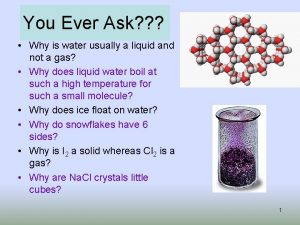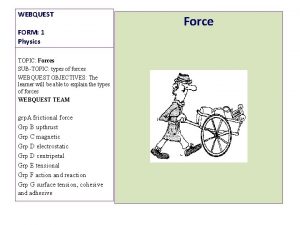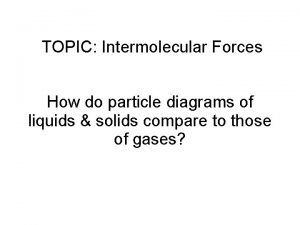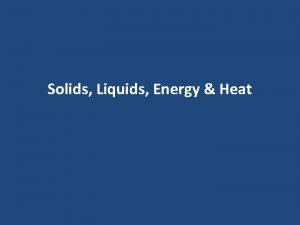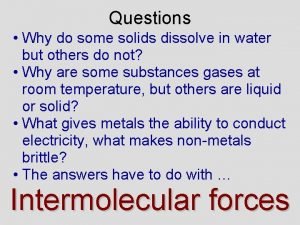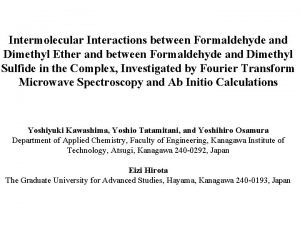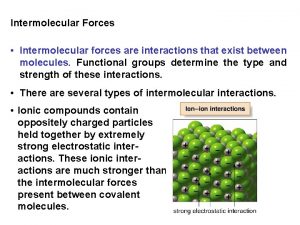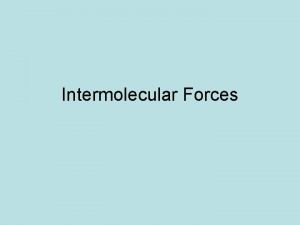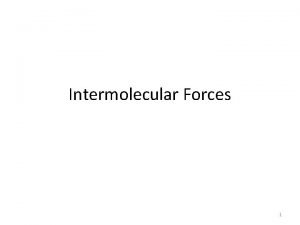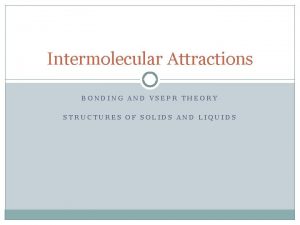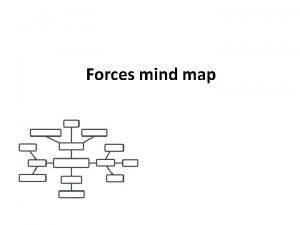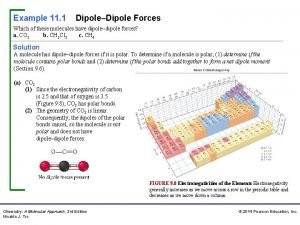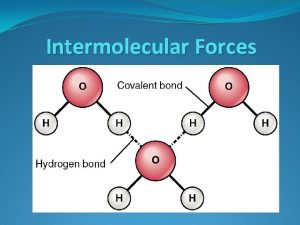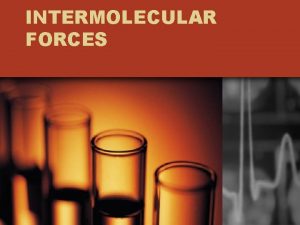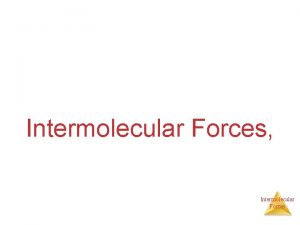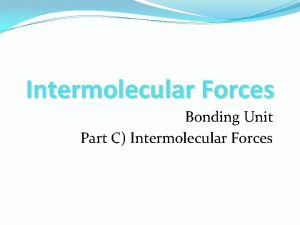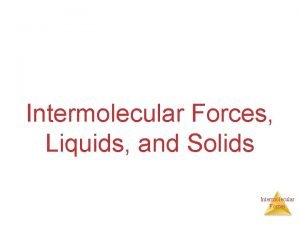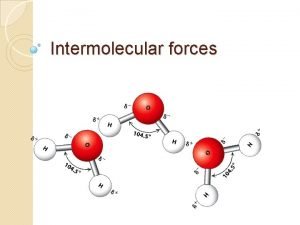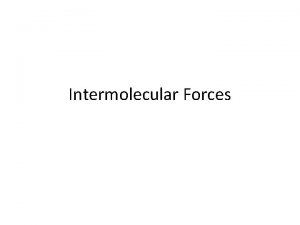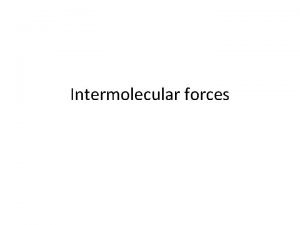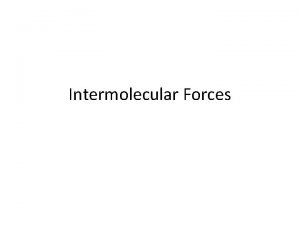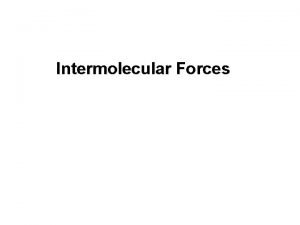Intermolecular Forces IMF Part II Effect of IMF

























- Slides: 25

Intermolecular Forces (IMF) Part II: Effect of IMF on Changes of State (based on Chap. 12 Sec 4 -7 of Jespersen 6 th Ed) Dr. C. Yau Spring 2014 1

Changes of State: a Dynamic Equilibrium "Change of state" refers to a change in physical state, such as a solid to a liquid and a liquid to gas. http: //www. youtube. com/watch? v=LBj. RDF 4 XV 8 Q "Equilibrium" refers to the state of a reversible reaction when there is no further VISIBLE change in the ratio of amount of reactants to amount of products. 2

Dynamic Equilibrium liquid gas The term "dynamic equilibrium" stresses the fact that even though the amounts of liquid & gas is no longer changing, there is still something very active going on. The liquid is still vaporizing into a gas, and gas is still condensing to the liquid! No VISIBLE change is observed because the forward & reverse rates are now EQUAL. 3

Evaporation of Liquid in Sealed Container Fig. 12. 21 p. 543 Why must the container be sealed? 4

Dynamic Equilibrium liquid gas At first the rate of vaporization is fast, but as the molecules in the liquid phase decreases, the rate slows down. Meanwhile the amt of gas molecules increases, and the rate of condensation increases, until the rates are equal & we say an equilibrium has been reached. There is no more visible change in the amt of liquid & gas. 5

Melting Involves Equilibrium (Fig. 12. 22 a) shows the process of melting, at an equilibrium. As long as no heat is added or removed, at equilibrium, the melting and freezing are at equal rate & the number of particles in the solid becomes constant. (Fig. 12. 22 b) shows the process of sublimation, at an equilibrium. As long as no heat is added or removed, at equilibrium, the sublimation and deposition are at equal rate & the number of particles in the solid becomes constant. 6

Energetics in Changes of State Think about the various changes of state and decide which processes are exothermic, and which ones are endothermic. E solid to liquid endothermic GAS liquid to gas endothermic gas to liquid exothermic liquid to solid exothermic LIQUID SOLID Now put the states in an E diagram. Which state should be on the bottom? 7

Vapor Pressure In changes of states, we are particularly interested in the vapor pressure above the liquid or solid. It is simply the pressure of the vapor above the liquid or solid, often abbreviated as vp. At equilibrium, the vp over a liquid is called the equilibrium vp of the liquid. This vp is dependent on… (1) Temperature (2) strength IMF 8

Fig. 12. 23 p. 545 Vapor Pressure 1 atm Significance of vp =1 atm? Vp increases with temperature. Why? Why are the curves different for the different liquids? 9

Effect of IMF on VP If the IMF of a liquid is strong, what do you expect its vp to be like? high vp or low vp? Increase of IMF leads to a decrease in vp. Ether refers to diethyl ether: CH 3 CH 2 OCH 2 CH 3 It is not linear! It is bent at O, like water. However, unlike water, it does NOT have Hbonding. Compared with water, ether would have the lower IMF, and therefore higher vp. Now we have a way to tell whether the IMF is strong or not…just by measuring the vp of the liquid! 10

Vapor Pressure Some factors do NOT affect the vp: 1) surface area of the liquid 2) volume of the liquid 3) volume of the container Fig. 12. 24 p. 546 Effect of Volume on VP a) Equilibrium for smaller volume of container. b) Volume of container is increased, upsetting the equilibrium. c) Equilibrium is reached again for the larger volume. VP returns to the original value. 11

Vapor Pressure of Solids have vapor pressures just like liquids, however, they are generally much lower as the IMF of solids are always stronger than that of the liquids. As with liquids, the vp decreases with the increase in the strength of the IMF. Na. Cl has very strong ionic bonds, and VP is essentially zero at room temperature. 12

Relationship of BP with VP DEFINITION OF BP (LEARN THIS!) The boiling point is the temperature at which the vp is equal to the atmospheric pressure. Bubbles can't form until the vp is at least the pressure of the atmosphere. 13

Effect of Atmospheric Pressure on BP normal atm pressure Water boils at 100 o. C Denver at 5283 ft (1 mi above sea level) has 0. 82 atm = 0. 82 atm x (760 torr/1 atm) = 623 torr Water boils at… 92 o. C Link to check altitude and atmospheric pressure of various cities. 1 psi = 0. 06803 atm http: //www. turblex. com/altitude/index. cfm 110 o. C 14

How a Pressure Cooker Works The tight seal allows the pressure to build to 15 pounds per square inch (psi) above atmospheric pressure. That raises the boiling point to about 121°C or 257 °F. Why is that desirable? A pot roast that normally takes 2 -3 hours can be cooked in 30 minutes. 15

Effect of IMF on BP H 2 S BP 60 C H 2 Se 41 C H 2 Te 2 C What is the trend? Why is there such a trend? Let us now examine this graphically. 16

H 2 O H 2 Te ●? H 2 O H 2 Se H 2 S 17

Effect of IMF on BP H 2 O H 2 Se H 2 Te BP 100 C 60 C 41 C 2 C The increase in BP from H 2 S to H 2 Se to H 2 Te is due to the increase in size of the Group VIA elements (increase in London forces). H 2 O is far above what one would expect, due to Hbonding. What other set of compounds should we examine? 18

Effect of IMF on BP NH 3 As. H 3 ●? NH 3 PH 3 19

HF HI ●? HF HBr HCl 20

Energy of Changes of State Fusion refers to melting. molar ΔH fusion = heat transfer when one mole of a solid melts molar ΔH vap= heat transfer when one mole of a liquid vaporizes molar ΔH sublimation= heat transfer when one mole of a solid sublimes molar ΔH condensation= heat transfer when one mole of a gas condenses Which of these have negative signs? How do these values change with IMF? 21

trend? ? C 6 H 14 has only London forces, why is its Hvap higher than that of NH 3? 22

Fig. 12. 27 p. 549 Heating Curve When heat is added and the T increases, energy is added into the kinetic energy. (Particles are moving faster and colliding with more force. ) When heat is added but the T stays constant, energy is added into the potential energy. (Intermolecular forces are 23 weakened/broken. Particles are moving further apart. )

Fig. 12. 27 p. 549 Cooling Curve 24

Example 12. 2 p. 550 Liquid sodium metal is used as heat transfer material to cool nuclear reactors. How much heat is required to heat 75. 0 g of sodium from 25. 0 o. C to 515. 0 o. C? The melting point of sodium is 97. 8 o. C; the specific heat of solid sodium is 1. 23 J/g o. C; the molar heat of fusion of sodium is 2. 60 k. J/mol; and the specific heat of liquid sodium is 1. 38 J/g o. C. We will assume that the specific heats do not change with temperature. Practice Exercises: 12. 8 & 12. 9 p. 551 25
 Intra vs intermolecular forces
Intra vs intermolecular forces Intra vs intermolecular
Intra vs intermolecular Covalent bond intermolecular forces
Covalent bond intermolecular forces Ch2cl intermolecular forces
Ch2cl intermolecular forces Intermolecular forces webquest answers
Intermolecular forces webquest answers Imf
Imf 3 types of intermolecular forces
3 types of intermolecular forces Concept of imfa
Concept of imfa How intermolecular forces affect solvation
How intermolecular forces affect solvation London dispersion forces induced dipole
London dispersion forces induced dipole Phthatic
Phthatic Intermolecular forces formaldehyde
Intermolecular forces formaldehyde Intermolecular forces symbol
Intermolecular forces symbol Strength of intermolecular forces
Strength of intermolecular forces Strength of intermolecular forces
Strength of intermolecular forces Van der waals attraction
Van der waals attraction Intermolecular forces present in hbr
Intermolecular forces present in hbr Strongest to weakest intermolecular forces
Strongest to weakest intermolecular forces Geckos and intermolecular forces
Geckos and intermolecular forces Dispersion forces examples
Dispersion forces examples Strongest to weakest intermolecular forces
Strongest to weakest intermolecular forces Similarities of intermolecular and intramolecular forces
Similarities of intermolecular and intramolecular forces Type of intermolecular forces
Type of intermolecular forces Intermolecular forces hydrogen bonding
Intermolecular forces hydrogen bonding Intermolecular forces concept map
Intermolecular forces concept map Ch2cl intermolecular forces
Ch2cl intermolecular forces



